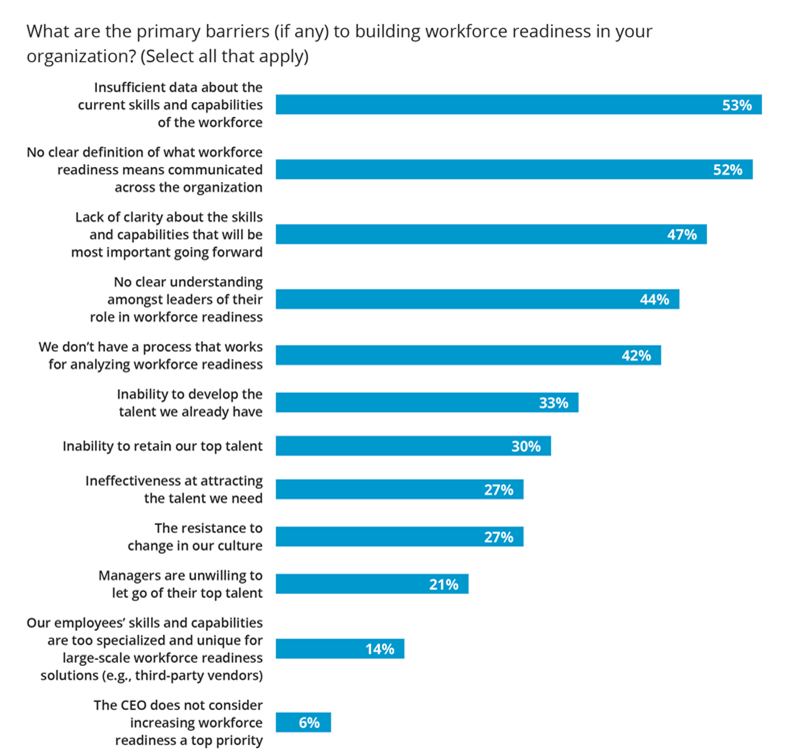What is Workforce Readiness? And Why Aren’t You Measuring It?

Expanding on a well-known quote from the late management thinker Peter Drucker, you can’t manage and improve what you don’t define, communicate, and measure. Without this level of shared understanding of a process or concept, individuals will counter each other at every turn and won’t be all rowing the boat in the same direction or at the same speed.
What is workforce readiness?
The Accelerating Workforce Readiness study by the Institute for Corporate Productivity (i4cp)—the key findings brief will be published in early fall—found that only 30% of survey participants believe to a high or very high extent that their organization’s workforce currently has the skills and capabilities necessary to advance its strategy over the next one-to-three years. That is one rough and ready definition of workforce readiness.
Another good description would be having the right people, in the right roles, at the right time, doing the right work—and in a nod to our current times—from the right location, to advance the organization’s strategy over the next one-to-three years. Additional elements such as culture, well-being, and inclusion are also critical to workforce readiness—because your people can have all the right skills, but if they are burned out or not motivated to produce, readiness for what is coming will suffer.
Precise definitions of workforce readiness vary based on industry, culture, or other specifics—what is important is to define what it means for your organization, what its components are, and how to measure it over time.
Communicating what workforce readiness means
Unfortunately, not communicating a clear definition of what workforce readiness is across the organization was cited by 52% of survey participants from larger organizations (those with >1,000 employees) as a primary barrier to building workforce readiness—very closely following insufficient data about the current skills and capabilities of the workforce.
Given this common lack of a clear definition that is understood across the organization, it was not surprising that participants also said that their organizations suffer almost as often (44%) from their leaders not understanding their critical roles in establishing and maintaining workforce readiness.
For example, 42% of survey respondents reported that managers in their organizations hoard talent rather than encourage internal movement. Leaders also play important roles in talent development, but there is clearly a lot of room for improvement as only 12% said their organization’s current upskilling / reskilling efforts are highly or very highly effective.
The need for more workforce readiness measurement
Among the top five barriers to workforce readiness (cited by 42% of survey participants) is the lack of an effective process for analyzing workforce readiness. More specifically, most organizations simply do not measure and report on enough aspects of workforce readiness. Indeed, only two metrics—employee engagement and employee retention—were cited by over 50% of participants as among measures used to determine if their organization’s workforce is prepared for the future.
Those from high-performance organizations reported using a much wider range of metrics than their lower-performing counterparts. Leveraging i4cp’s Market Performance Index (which considers revenue, profitability, market share, and customer satisfaction over five years), three metrics were found to be used 2X more often by high-performance organizations than lower performers: company culture, time to full productivity, and the status of upskilling/reskilling and other learning and development data.
These aren’t surprising, as a positive, strong company culture and upskilling/reskilling initiatives are clearly both important for employees to be ready for whatever comes around the corner, while time to full productivity would seem to be a defining, core aspect of workforce readiness.
 Organizations can’t manage and improve on what isn’t defined, communicated, and measured. In order to be agile in the face of uncertainty, organizations must have a solid foundation, and this means defining, communicating, and measuring workforce readiness so that leaders are aligned to advance the organization’s strategy now and in the future.
Organizations can’t manage and improve on what isn’t defined, communicated, and measured. In order to be agile in the face of uncertainty, organizations must have a solid foundation, and this means defining, communicating, and measuring workforce readiness so that leaders are aligned to advance the organization’s strategy now and in the future.
View more data and insights from i4cp’s Accelerating Workforce Readiness study, available exclusively to i4cp members. The key findings brief will be available in early fall.
Thomas Stone is a Senior Research Analyst at i4cp







